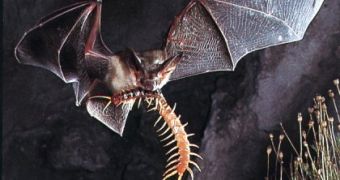1. In the depths of the caves, where current airs, temperature and humidity are practically constant, bats seem to know exactly when it's time to go hunting. In fact, when atmospheric pressure decreases (before a rainfall), the insects gather at low altitude and are easier to be preyed. The atmospheric pressure varies both inside and outside the grottoes inhabited by bats. Bats know that low atmospheric pressure means more food and they can even detect these variations with the help of a sensory organ placed in the middle ear that only bats and birds possess.
2. Bats are famous for their ultrasound technique for space orientation while flying in the dark, called echolocation. This is efficient over short ranges and enables bats to locate prey and obstacles.
Scientists were puzzled for long about how bats manage to navigate long distances in the dark. Ultrasound echolocation does not serve for this: they use Earth's magnetic field, in a similar way to migrating birds. Bats, like birds, use sunset as a directional marker also.
Exposure to artificial magnetic fields confuses the bats, making them to fly in the wrong direction. Bats exposed to the clockwise magnetic fields fly east, while those in the opposite group fly west.
Until now, a magnetic sense has been also detected in salamanders, lobsters and sea turtles.
A simple compass sense is based on particles of magnetite (a magnetic mineral) and bats do have magnetite in their bodies. Some birds can also "see" changes in light intensity in different locations within the Earth's magnetic field. This sophisticated sensory apparatus delivers an internal "map sense" of where the birds are on the globe.
3. Of course, bats are most famous for their ultrasound sonar. Bats are made of two groups: the so-called Megachiroptera ("big bats", flying foxes and relatives) and Microchiroptera ("small bats", typical bats). This division is somehow a misnomer, as some flying foxes also can be small, while some "small bats" can be quite large.
Microchiroptera are much more diverse and diversified, and their echolocation apparatus is much more sophisticated and complex, while amongst Megachiroptera only species of the Rousettus genus can emit ultrasounds, in a rudimentary fashion (being the only flying foxes inhabiting grottoes).
Out of about 1,100 bat species, some 800 emit ultrasounds through their mouths, and the rest of 300 species do it through their noses. The last ones have smaller and less sophisticated ears than the former ones. Ghost-faced bats (Mormoops) use their lips like speaking-tube for emitting the ultrasounds.
Nose ultrasound emitting bats are divided into two evolutionary groups, the leaf nosed (including the infamous vampire bats) and the horseshoe bats, which possess extremely sophisticated patterns of creases, flaps, wrinkles and grooves around the nostrils dubbed "noseleaves" or "horseshoe". These complex facial masks make bats famous in the gallery of ugliness!
The microbat calls (clicks) vary from 14 to over 100 kHz, well beyond our ear's range. We hear as clicks what's lower than 20 kHz, but sounds having frequencies of 20-140 kHz are ultrasounds we do not hear. Swallowing the prey does not perturb the ultrasound emission, as there is a passage reserved for the food. One click lasts 0.002 seconds and the bats emit 10-20 clicks per second. When they detect an insect, the click frequency goes to 250 per second.
4. Humans and mammals have two types of photoreceptor cells in the retina: the cones for daylight vision and color vision, and the more sensitive rods for night vision.
Megachiroptera have large eyes, developed brain visual centers while Microchiroptera have developed auditory centers). Flying foxes often employ exposed treetops as daytime roosts, where they form large colonies. They forage at night, with nectar and fruit, using visual and olfactory clues.
While navigating to the foraging grounds at dusk and returning to the daytime roost at dawn, the animals only employ vision, and on moonless nights, they are impeded to fly, so they fast. Visual navigation at twilight and occasionally during the daytime made researchers challenge the old concept that fruit bats only possess rods for night vision.
The nocturnal fruit bats (flying foxes) possess cones in addition to rods, making about 0.5 % of the photoreceptor cells. Cats and dogs have 2-4 % cones, and humans, with highly developed diurnal vision just 5 % cones.
Flying fox species have two spectral cone types, blue cones that track short-wave light, and green cones for middle-to-long-wave light. This dichromatic color vision is one of the most common mammalian conditions (human, monkeys, birds have trichromatic vision, having also red cones). The retinas of other three studied genera of Megachiroptera: Rousettus (rousette fruit bat), Eidolon (straw colored fruit bat), and Epomophorus (epauletted fruit bat) lacked the blue cones, possessing just green cones; these species are colorblind, like the Microchiroptera.
Flying foxes (Pteropus) roost in large open treetops, exposed to birds of prey, as they are too big to employ tree hollows or small caves (these bats can reach 1.8 m (6 ft) in wingspan and 1 kg (2.5 pounds) in weight), and visual 'early warning' is required for survival. These bats don't sleep all day long, changing often their positions in the tree and interacting between them. Young flying foxes can also execute training flights during the day, and a good sight helps.
The much smaller Rousettus roosts in caves (where they use echolocation in the total darkness) and Epomophorus in the darkest parts of large trees. While foraging at night, the bats rely on the more sensitive rods that deliver no color information. Cones are used more in twilight and dawn light while flying from or to the shelter.

 14 DAY TRIAL //
14 DAY TRIAL //